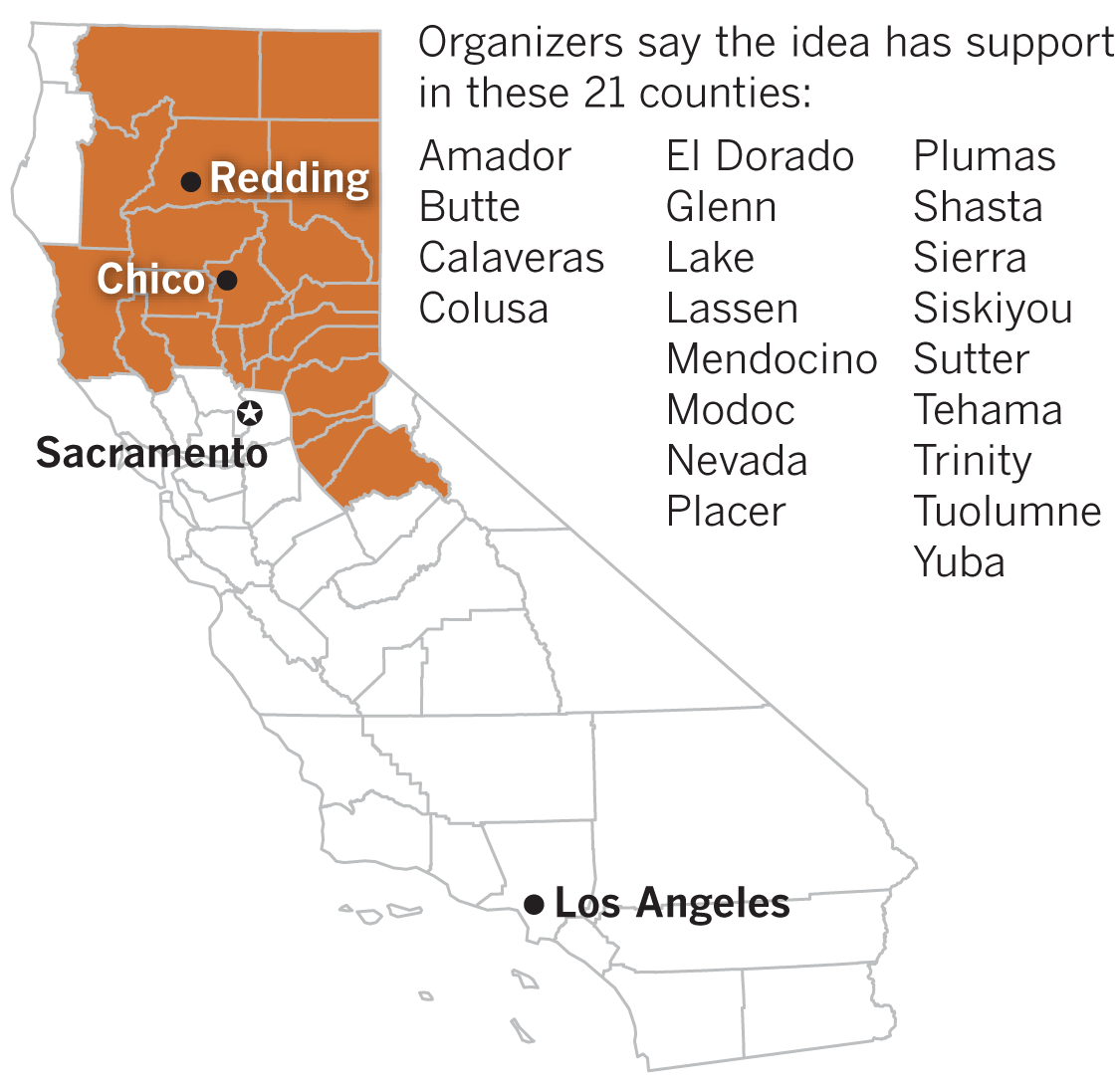What is Jefferson?
Breaking up California into separate states is an age-old idea. Now it's being revived in earnest by the residents of 21 Northern California counties who say they are fed up with their voices being drowned out. Many of them want to form a new state named after America's third president, Thomas Jefferson.
Experts say their cause is unlikely, but organizers are setting their hopes on a federal lawsuit alleging an unconstitutional lack of representation.

If they win their case, Jefferson supporters hope California will be forced to add thousands of members to the State Legislature, or that it will refuse and let them break away to form an independent state with its own laws, flag and capital.
Read more about the Jefferson movement, its characters and chances in today's story by Hailey Branson-Potts.
Where is it?
The State of Jefferson would include most, but not all, California counties north and east of the the Bay Area. Its largest cities would be Redding and Chico. Two northwestern counties, Humboldt and Del Norte, are not currently included.

Who lives there?
If Jefferson broke away, it would take 1.7 million residents with it, approximately 5% of California's current population.
That might not sound like much, but it's nearly equal to the populations of San Diego and Long Beach combined.
Roughly 5% of Californians live there now
The new state would be whiter, older and poorer than the one it would leave behind.
Jefferson's population would be nearly three-quarters white. Its exit would boost the share of Latinos in the rest of California, where they would suddenly outnumber whites by more than 800,000.
Drastically different demographics
- White
- Non-white
The new state's median age would be 31, four years older than the rest of California. Nearly one in three Jeffersonians would be 50 or older.
Jefferson would also be much less affluent, with a median household income of $57,000. Its departure would raise the rest of California’s median income to roughly $72,000.
Red State in waiting
A new state would send two new senators to Washington. Because the area's 392,000 registered Republicans greatly outnumber its 303,000 Democrats, both senators would likely be members of the GOP.
The breakaway could also complicate close presidential races by peeling electoral votes away from reliably blue California. Although the rest of the state voted overwhelmingly for Hillary Clinton in 2016, President Trump won 53% of the vote in what would be Jefferson. Many other voters there chose a third-party candidate.


Another Idaho
Even after cleaving off Jefferson's 1.7 million residents, California would remain the nation's most populous state.
Its new neighbor to the north would rank 39th, between West Virginia and Idaho, with a population several times larger than America's sparsest states.
Jefferson's racial makeup also most resembles Idaho, which is home to similar proportions of whites and Latinos.
| Rank | State | Population |
|---|---|---|
| Rank34 | StateKansas | Population2,892,987 |
| Rank35 | StateNevada | Population2,798,636 |
| Rank36 | StateNew Mexico | Population2,084,117 |
| Rank37 | StateNebraska | Population1,869,365 |
| Rank38 | StateWest Virginia | Population1,851,420 |
| Rank39 | StateJefferson | Population1,738,337 |
| Rank40 | StateIdaho | Population1,616,547 |
| Rank41 | StateHawaii | Population1,406,299 |
| Rank42 | StateMaine | Population1,329,100 |
| Rank43 | StateNew Hampshire | Population1,324,201 |
| Rank44 | StateRhode Island | Population1,053,661 |
| Rank45 | StateMontana | Population1,014,699 |
| Rank46 | StateDelaware | Population926,454 |
| Rank47 | StateSouth Dakota | Population843,190 |
| Rank48 | StateAlaska | Population733,375 |
| Rank49 | StateNorth Dakota | Population721,640 |
| Rank50 | StateVermont | Population626,604 |
| Rank51 | StateWyoming | Population579,679 |
Sources: U.S. Census, California Secretary of State, Times analysis
Credits: Additional reporting and production by Staff Writer Hailey Branson-Potts and Data Editor Ben Welsh